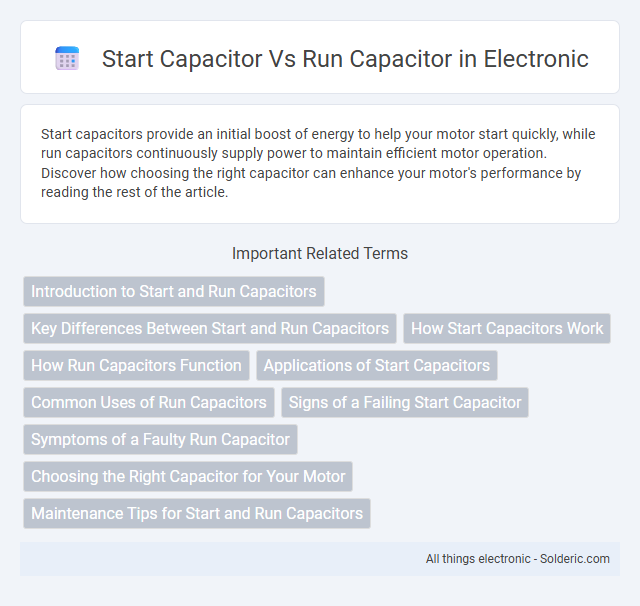Start capacitors provide an initial boost of energy to help your motor start quickly, while run capacitors continuously supply power to maintain efficient motor operation. Discover how choosing the right capacitor can enhance your motor's performance by reading the rest of the article.
Comparison Table
| Feature | Start Capacitor | Run Capacitor |
|---|---|---|
| Function | Provides high starting torque to electric motors | Improves motor efficiency and running performance |
| Operation Time | Active only during motor startup | Remains active during motor operation |
| Capacitance Value | High capacitance (70-120 uF) | Lower capacitance (5-50 uF) |
| Voltage Rating | Typically rated for 250-450V | Typically rated for 370-440V |
| Physical Size | Larger in size due to higher capacitance | Smaller and compact |
| Connection | Connected via a centrifugal or current relay | Connected in series with the motor running winding |
| Durability | Designed for short-term use; may fail if overused | Designed for continuous operation; longer lifespan |
| Typical Applications | Single-phase induction motors requiring high starting torque | Fans, air conditioners, and pumps for smooth operation |
Introduction to Start and Run Capacitors
Start capacitors provide an initial boost of energy to help your motor begin turning, delivering high capacitance for a short duration during startup. Run capacitors maintain a continuous flow of energy to improve motor efficiency and performance throughout operation by offering lower capacitance but constant support. Understanding the distinct roles of start and run capacitors ensures optimal functioning and longevity of your electric motor system.
Key Differences Between Start and Run Capacitors
Start capacitors provide a high burst of energy to help your motor overcome initial inertia during startup, while run capacitors deliver a continuous, lower energy supply to maintain efficient motor operation. Start capacitors are typically larger, designed for short-term use, and disconnect from the circuit once the motor reaches a certain speed; run capacitors remain in the circuit throughout motor operation for stability and power factor correction. Understanding these distinctions ensures optimal motor performance and longevity in HVAC systems and appliances.
How Start Capacitors Work
Start capacitors provide a high capacitance value that generates an initial boost of electrical energy, enabling your motor to overcome inertia and start turning. They momentarily store and release energy during motor startup, creating a phase shift that increases starting torque. Once the motor reaches a certain speed, the start capacitor disconnects from the circuit to prevent damage and ensure efficient operation.
How Run Capacitors Function
Run capacitors maintain a continuous electrical charge to keep the motor windings energized, improving efficiency and ensuring smooth operation. They enable consistent torque by providing a steady phase shift in the motor's current, which reduces energy consumption and heat buildup. Unlike start capacitors, run capacitors remain connected throughout the motor's operation for prolonged performance and reliability.
Applications of Start Capacitors
Start capacitors are primarily used in single-phase induction motors to provide a high starting torque by creating a phase shift during startup. Common applications include air compressors, HVAC systems, and refrigeration units where instant motor start is crucial. These capacitors are designed to operate only briefly during motor startup, ensuring efficient performance without continuous power consumption.
Common Uses of Run Capacitors
Run capacitors are commonly used in HVAC systems, ceiling fans, and air conditioners to provide continuous, efficient motor operation and improve energy consumption. They help maintain a constant voltage supply to the motor windings, enhancing the motor's running efficiency and longevity in applications requiring sustained power. These capacitors are ideal for single-phase induction motors found in pumps, compressors, and conveyor systems, where smooth and reliable performance is essential.
Signs of a Failing Start Capacitor
A failing start capacitor often causes your HVAC system or motor to struggle with starting or produce a humming noise without initiating rotation, indicating insufficient starting torque. Other signs include delayed motor startup, increased energy consumption, or overheating, which can result in frequent tripping of circuit breakers. Recognizing these symptoms early can prevent damage to the motor and ensure smooth operation.
Symptoms of a Faulty Run Capacitor
A faulty run capacitor in HVAC systems often causes a motor to struggle starting, resulting in humming noises and increased energy consumption. Common symptoms include the motor overheating, reduced efficiency, and intermittent operation due to insufficient electrical phase shift. Detecting a swollen or leaking run capacitor can confirm failure, necessitating prompt replacement to avoid further motor damage.
Choosing the Right Capacitor for Your Motor
Choosing the right capacitor for your motor ensures optimal performance and longevity. Start capacitors provide a high burst of energy to initiate motor rotation, while run capacitors sustain efficient motor operation during continuous use. Evaluating your motor's specifications and application needs helps you select between start and run capacitors to enhance efficiency and prevent electrical issues.
Maintenance Tips for Start and Run Capacitors
Regularly inspect start and run capacitors for bulging, leaking, or corrosion to prevent motor failure and maintain optimal performance. Use a multimeter to test capacitance values, ensuring they match the manufacturer's specifications for reliable operation. Replace faulty capacitors promptly with high-quality equivalents to avoid damage to compressor motors or HVAC systems.
Start capacitor vs run capacitor Infographic

 solderic.com
solderic.com